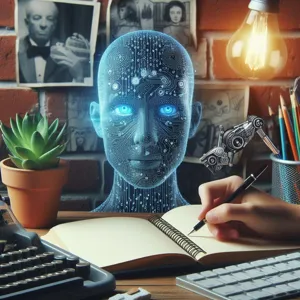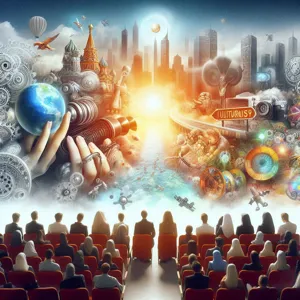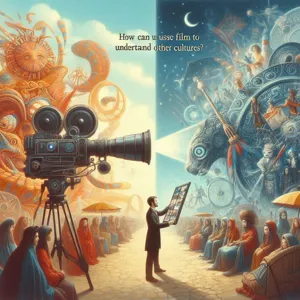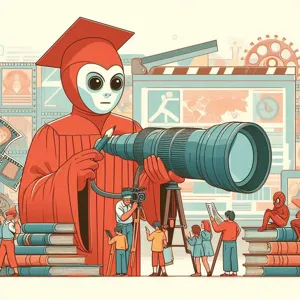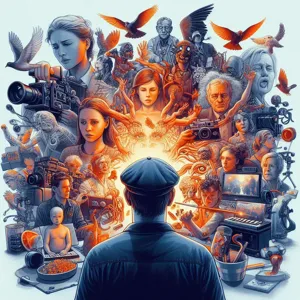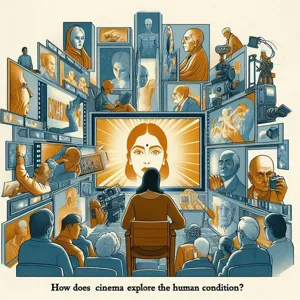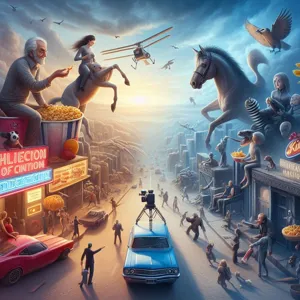In an age where our lives are increasingly filled with digital distractions, the power of books remains unrivaled in their ability to transport us to new realms of thought and understanding.
“Exploring the World Through Pages: How Books Expand Your Philosophical Horizons” delves into the profound impact literature has on our philosophical perspectives and personal growth. Each page turned offers a glimpse into the minds of great thinkers, inviting us to challenge our beliefs, question our assumptions, and embrace new ideas. Whether it’s the timeless wisdom of ancient philosophers or the groundbreaking theories of contemporary authors, books serve as portals to diverse cultures, experiences, and ideologies. This blog post will explore how immersing ourselves in the written word not only broadens our intellectual landscape but also enriches our emotional and spiritual lives, ultimately shaping a more enlightened worldview. Join us on this literary journey as we uncover the transformative power of reading and its ability to expand our philosophical horizons.
1. Introduction: The Power of Reading in Shaping Philosophy
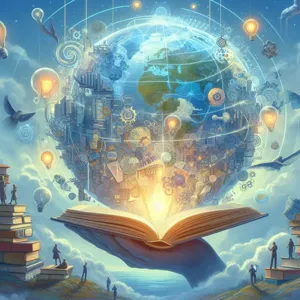
Reading has an unparalleled capacity to shape our understanding of the world, acting as a bridge between diverse cultures, ideologies, and time periods. Each book serves as a portal, offering readers not just a narrative but a profound exploration of human thought and experience. From ancient philosophical texts that ponder the essence of existence to contemporary works that challenge our views on morality and society, the written word has the power to expand our philosophical horizons in ways we often overlook.
At its core, reading encourages critical thinking and introspection. It invites us to grapple with complex questions and dilemmas, pushing us beyond the confines of our own perspectives. As we immerse ourselves in the ideas of others—be it through the lens of Plato’s dialogues, the ethical quandaries posed by modern philosophers, or the vivid narratives woven by fiction writers—we are compelled to confront our beliefs and assumptions. This encounter can be both enlightening and transformative, leading to a deeper understanding of not only our own philosophies but also the philosophies of others.
Moreover, books serve as a sanctuary for inquiry and curiosity. They provide a safe space to explore challenging concepts and to engage with thoughts that may be uncomfortable or unfamiliar. In a world that often pushes us toward conformity, reading allows us to embrace complexity and diversity in thought, fostering an appreciation for the nuances of human experience. In this blog post, we will delve into the myriad ways in which books can illuminate our philosophical journey, encouraging us to question, reflect, and grow as thinkers and individuals. Join us as we explore the profound impact of literature on our philosophical development and the endless possibilities that await within the pages of a book.
2. How Books Challenge Our Beliefs
Books have a unique power to challenge our beliefs, prompting us to question the very foundations of our understanding. When we immerse ourselves in the pages of a thought-provoking narrative or an incisive philosophical treatise, we are often confronted with perspectives that diverge from our own. This confrontation can be both unsettling and enlightening, pushing us beyond our comfort zones and inviting us to examine the assumptions we’ve held as truths.
Consider how a novel set in a vastly different culture can illuminate the intricacies of human experience. Through the eyes of its characters, we might encounter beliefs, traditions, and values that starkly contrast with our own. This exposure not only fosters empathy but also compels us to reconsider our preconceived notions. For instance, reading Chimamanda Ngozi Adichie’s “Americanah” invites readers into the complexities of race and identity, challenging simplistic understandings and encouraging deeper dialogues about belonging and cultural heritage.
Similarly, philosophical texts like Friedrich Nietzsche’s “Beyond Good and Evil” or Simone de Beauvoir’s “The Second Sex” push us to scrutinize societal norms and moral frameworks. These works ask us to confront uncomfortable questions about power, gender, and existence itself. As we navigate through their arguments, we find ourselves wrestling with our values, often leading to a profound internal reevaluation.
Moreover, the act of reading itself is a dialogue between the author and the reader, a space where conflicting ideas can coexist and be explored. This intellectual engagement sparks curiosity and critical thinking, essential components in the journey of personal growth. By challenging our beliefs, books serve not only as mirrors reflecting our thoughts but also as windows into new worlds, ideas, and possibilities. Embracing this challenge enriches our understanding of ourselves and the diverse tapestry of human experience, ultimately expanding our philosophical horizons and inviting us to grow in ways we never imagined.
3. The Role of Fiction in Understanding Different Perspectives
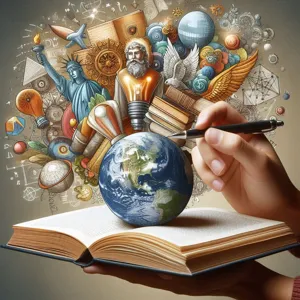
Fiction possesses a unique power to transport readers into the hearts and minds of characters vastly different from themselves. Through the pages of a novel, whether it’s a sweeping historical epic or a contemporary tale, readers are invited to step into the shoes of diverse individuals, experiencing life through their eyes. This immersive journey not only entertains but also cultivates empathy and understanding—essential tools for expanding one’s philosophical horizons.
Consider the impact of classic masterpieces like “To Kill a Mockingbird” or modern narratives such as “The Kite Runner.” These stories allow us to witness the complexities of human nature, morality, and the often painful realities faced by others. They challenge our preconceived notions and prompt us to reevaluate our beliefs and values. As we engage with the struggles and triumphs of characters grappling with their own philosophies of life, we begin to see the world through a kaleidoscope of experiences and emotions that we may never encounter in our daily lives.
Moreover, fiction often presents moral dilemmas and philosophical questions that resonate beyond the text, inviting readers to ponder their own positions on justice, love, sacrifice, and the nature of existence. The act of reading becomes a dialogue, not just with the author but with ourselves as we question, analyze, and reflect on the narratives unfolding on the page.
By exploring the rich tapestry of human experiences woven into fiction, we can broaden our understanding of societal issues, cultural differences, and the myriad ways people navigate their realities. This exploration ultimately leads to a more profound appreciation for the complexities of life and the interconnectedness of our shared human experience. In a world that can often feel divided, fiction serves as a bridge, fostering understanding and compassion through the stories that resonate across time and space.
4. Non-Fiction: Expanding Knowledge and Critical Thinking
Non-fiction books serve as gateways to a myriad of realities, ideas, and disciplines, inviting readers to engage with the world in a profound and transformative way. Unlike fiction, which can transport us to imaginary realms, non-fiction grounds us in the tangible, providing insightful explorations of history, science, culture, and philosophy. This genre encourages readers to expand their knowledge base and hone their critical thinking skills.
When diving into non-fiction, you may find yourself grappling with complex subjects that challenge your preconceptions. Books on psychology, for instance, can illuminate the intricacies of human behavior, prompting you to reconsider your own motivations and those of the people around you. Works on sociology can unravel the fabric of societal norms and structures, encouraging you to question the status quo and consider alternative perspectives.
Moreover, non-fiction often presents arguments and theories that require careful analysis and reflection. Engaging with these texts fosters a habit of critical thinking, prompting you to weigh evidence, assess biases, and draw informed conclusions. Whether you’re delving into biographies that chronicle the lives of influential figures or immersing yourself in philosophical treatises that dissect morality and existence, each page invites you to think deeply and engage thoughtfully with the material.
In an age flooded with information, the ability to discern credible sources and synthesize diverse viewpoints is invaluable. Non-fiction books not only provide you with facts and figures but also equip you with the tools to navigate complex issues, fostering a more nuanced understanding of the world. By expanding your intellectual horizons through non-fiction, you not only become more informed but also more empathetic and open-minded—qualities essential for a well-rounded philosophical outlook.
5. Classic Philosophical Texts: Foundations of Thought
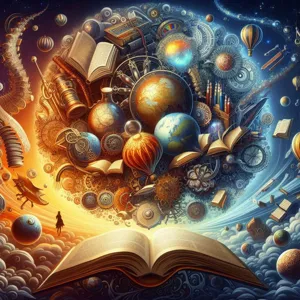
Classic philosophical texts serve as the bedrock upon which much of modern thought is built. These works, penned by luminaries such as Plato, Aristotle, Kant, and Nietzsche, invite readers to engage with the foundational questions of existence, morality, knowledge, and the human condition. Delving into these texts is akin to entering a grand dialogue that has spanned centuries, where each page is a conversation with the greatest minds in history.
Reading Plato’s “The Republic,” for instance, opens a window into the ancient world’s exploration of justice and the ideal state, prompting readers to consider what it means to live a good life in a society. Aristotle’s “Nicomachean Ethics” encourages introspection about virtue and happiness, challenging us to evaluate our own ethical frameworks. Meanwhile, Kant’s “Critique of Pure Reason” dismantles and reconstructs our understanding of knowledge and perception, pushing us to grapple with the limits of human reason.
These texts are not merely academic exercises; they engage our intellect and stir our emotions. They provoke questions that are as relevant today as they were when they were written: What is the nature of reality? How should we treat one another? What is the meaning of freedom? As you journey through these classic works, you not only gain insight into the thoughts of the past but also cultivate a deeper understanding of your own beliefs and values.
Moreover, engaging with classic philosophical texts nurtures critical thinking. They challenge readers to dissect arguments, recognize biases, and form their own perspectives. This intellectual rigor is essential in today’s world, where we are inundated with information from countless sources. By grounding ourselves in philosophical foundations, we learn to navigate complexities with clarity and confidence.
Ultimately, exploring these timeless works enriches our philosophical horizons, equipping us with the tools to engage thoughtfully with the world around us. Whether you are a seasoned philosopher or a curious newcomer, immersing yourself in classic texts offers a transformative journey toward greater understanding and awareness.
6. Modern Philosophical Works: Contemporary Issues and Ideas
In our rapidly changing world, modern philosophical works serve as critical lenses through which we can explore pressing contemporary issues and ideas. Unlike classical texts that delve into timeless questions of existence, morality, and truth, today’s philosophers tackle the complexities of modern life, examining themes such as technology, identity, social justice, and environmental ethics.
For instance, the rise of digital technology and social media has spurred a wave of philosophical inquiry into the nature of selfhood and community. Thinkers like Sherry Turkle and Yuval Noah Harari challenge us to consider how our increasingly virtual lives affect our relationships and perceptions of reality. Their works prompt readers to reflect on whether a digital connection can truly replace the intimacy of face-to-face interaction and what that means for our understanding of human nature.
Moreover, contemporary philosophy often intersects with urgent societal debates. Books that address climate change, like those by philosopher and environmental activist Naomi Klein, compel us to reckon with our moral obligations to the planet and future generations. Klein’s work, alongside others in the field, urges readers to consider what it means to live ethically in a world facing ecological crisis.
Similarly, the discourse around social justice has been invigorated by modern philosophers such as Judith Butler and Cornel West, who dissect the fabric of power, privilege, and identity in today’s society. Their writings encourage readers to challenge systemic inequalities and foster a deeper understanding of intersectionality and collective responsibility.
Engaging with these contemporary philosophical texts not only broadens our intellectual horizons but also equips us with the tools to navigate the moral complexities of the modern world. As we delve into these ideas, we’re invited to reflect on our values, question our assumptions, and actively participate in the ongoing dialogue about what it means to live a good and meaningful life in today’s society. By exploring these modern works, readers can expand their philosophical understanding and apply these insights to the challenges we face now and in the future.
7. The Influence of Cultural Context on Philosophy
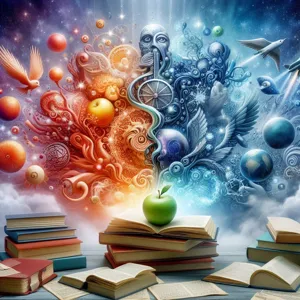
The influence of cultural context on philosophy is a profound aspect that shapes our understanding of the world, and books serve as the primary vessels through which these ideas are conveyed and explored. Each philosophical text is a reflection of the time, place, and society in which it was written. From the ancient dialogues of Plato, steeped in Athenian democracy, to the existential musings of Jean-Paul Sartre, shaped by the turmoil of World War II France, the cultural backdrop of a philosopher provides essential insights into their thoughts and arguments.
When readers immerse themselves in these texts, they not only engage with the philosophical ideas presented but also gain a deeper appreciation for the cultural narratives that influence them. For instance, Eastern philosophies such as Taoism and Buddhism emphasize harmony with nature, a concept that resonates deeply with the cultural practices and beliefs of Asian societies. In contrast, Western philosophies often grapple with themes of individualism, reason, and freedom, reflecting the historical evolution of Western thought and its cultural priorities.
Exploring these philosophical frameworks through literature invites readers to question their own cultural assumptions and consider how their backgrounds shape their views on existence, ethics, and society. By examining texts from diverse cultures, readers can cultivate a more nuanced understanding of global philosophical dialogues, recognizing the rich tapestry of human thought that transcends geographical boundaries.
Ultimately, engaging with philosophy through the lens of cultural context not only broadens our intellectual horizons but also fosters empathy and connection with our fellow human beings. The journey through these diverse perspectives challenges us to rethink our beliefs, prompting reflection and growth. In a world that often feels divided, books become essential tools for bridging cultural gaps, encouraging us to explore and appreciate the myriad ways in which humanity seeks to understand itself and its place in the universe.
8. How Diverse Genres Contribute to Philosophical Understanding
Diving into diverse genres is akin to embarking on a grand philosophical journey, where each book serves as a portal to new ideas, perspectives, and cultural landscapes. Literature is not monolithic; it is a vast tapestry woven from countless threads of human experience, emotion, and intellect. By exploring different genres, readers can engage with a multitude of philosophical frameworks that challenge preconceived notions and enrich understanding.
Consider the distinction between fiction and non-fiction. Fiction, with its imaginative narratives and character-driven plots, allows readers to grapple with ethical dilemmas, existential questions, and the complexities of human relationships. Works like Dostoevsky’s *Crime and Punishment* or Morrison’s *Beloved* invite readers to contemplate morality, guilt, and the weight of history, encouraging introspection and empathy that often transcend the written word.
On the other hand, non-fiction genres—such as philosophy, memoir, or historical accounts—offer a grounding in reality, presenting theories, lived experiences, and critical analyses that can profoundly shape one’s worldview. Engaging with philosophical treatises from thinkers like Kant, Nietzsche, or Arendt challenges readers to confront fundamental questions about existence, society, and individual agency. These texts not only broaden intellectual horizons but also provoke deep reflection on personal beliefs and values.
Moreover, genres such as science fiction and fantasy push the boundaries of philosophical inquiry even further. They invite readers to explore speculative realities, ethical conundrums regarding technology and humanity, and the nature of existence itself. Works like Asimov’s *Foundation* series or Le Guin’s *The Left Hand of Darkness* examine societal structures and human nature in ways that compel readers to think critically about the present and future of civilization.
Even genres like poetry and drama offer unique lenses for philosophical exploration. The concentrated language of poetry distills complex emotions and ideas into powerful imagery, while plays such as Shakespeare’s tragedies or Greek dramas pose timeless questions about fate, morality, and the human condition.
In essence, engaging with a rich variety of genres not only enhances literary appreciation but also fosters a deeper philosophical understanding. Each book adds a new layer to our comprehension of the human experience, urging us to embrace complexity, cultivate empathy, and expand our intellectual horizons. By stepping outside of familiar genres and exploring the vast landscape of literature, we unlock the potential for profound personal and philosophical growth.
9. Reading as a Tool for Empathy and Emotional Intelligence
In a world that often feels fragmented and divided, reading serves as a powerful tool for cultivating empathy and enhancing emotional intelligence. When you immerse yourself in the pages of a book, you step into the shoes of characters whose lives, experiences, and emotions may be vastly different from your own. This transformative journey allows you to explore diverse perspectives, fostering a greater understanding of the human condition.
Literature has a unique ability to illuminate the complexities of life, shedding light on struggles, triumphs, and the subtle nuances of interpersonal relationships. Whether it’s the poignant narrative of a young girl facing adversity in a war-torn country or the introspective musings of an aging philosopher grappling with existential questions, each story offers a window into the hearts and minds of others. As you connect with these characters, you begin to recognize the universal threads that bind us all—love, loss, hope, and resilience.
Moreover, reading fiction has been shown to enhance emotional intelligence by improving our ability to recognize and interpret emotional cues. Engaging with well-crafted narratives encourages you to pay attention to the details—facial expressions, dialogue, and the internal thoughts of characters. This heightened awareness translates into real-world interactions, allowing you to respond with greater sensitivity and understanding in your everyday relationships.
By making reading a regular part of your life, you not only expand your philosophical horizons but also cultivate a deep well of empathy. You learn to appreciate the richness of diverse human experiences and develop a compassionate outlook that can bridge divides in an increasingly polarized society. So, the next time you pick up a book, remember that you are not just entertaining yourself; you are embarking on a journey that enriches your mind and nurtures your soul. Reading, after all, is an invitation to connect with the world on a profoundly human level.
10. The Impact of Literature on Ethical Decision-Making
Literature, in its myriad forms, serves as a profound catalyst for ethical decision-making, inviting readers to grapple with moral dilemmas and sociocultural complexities that shape our worldviews. Through the lens of fiction, poetry, and essays, books introduce us to diverse characters and scenarios, each presenting unique challenges that compel us to reflect on our own values and beliefs.
Consider the moral quandaries faced by protagonists in classic novels such as Leo Tolstoy’s “Anna Karenina” or Fyodor Dostoevsky’s “Crime and Punishment.” As we immerse ourselves in the struggles of these characters, we are prompted to evaluate our ethical frameworks, question societal norms, and confront uncomfortable truths about human nature and morality. The nuanced portrayal of decisions made in desperate circumstances encourages empathy and a deeper understanding of the motivations behind actions—both admirable and reprehensible.
Moreover, non-fiction works delve into real-world issues, offering insights into the ethical implications of topics such as climate change, social justice, and technological advancements. Authors like Viktor Frankl in “Man’s Search for Meaning” illuminate the human capacity for resilience and moral choice, even in the darkest of times. These narratives not only inform us but also inspire us to engage with our own ethical beliefs, urging us to consider how our decisions impact others and the world around us.
As we turn the pages of these literary masterpieces, we are not just passive readers; we become active participants in a broader dialogue about ethics and morality. Each story challenges us to think critically, fostering a mindset that prioritizes reflection and intentionality in our decision-making processes. By exploring the rich tapestry of human experience through literature, we can expand our philosophical horizons, ultimately shaping a more compassionate and conscientious approach to the choices we make in our lives.
11. Book Recommendations for Expanding Philosophical Horizons
When it comes to expanding your philosophical horizons, the right book can be a transformative experience. Here are a few carefully curated recommendations that will not only challenge your thoughts but also encourage introspection and a deeper understanding of the human condition.
**1. “Meditations” by Marcus Aurelius**
This timeless classic offers profound insights from the Roman Emperor himself. Aurelius’ reflections on virtue, duty, and the nature of the universe provide a stoic framework for navigating life’s challenges. His thoughts encourage readers to cultivate inner peace and resilience in a world filled with chaos.
**2. “The Republic” by Plato**
Dive into Plato’s exploration of justice, the ideal state, and the philosopher-king. This dialogue not only introduces core concepts of Western philosophy but also provokes critical thinking about morality and governance. Engaging with Plato’s ideas will inspire you to question societal norms and reflect on your own beliefs about justice and ethics.
**3. “Being and Time” by Martin Heidegger**
For those ready to delve into existentialism, Heidegger’s masterwork provides a complex yet rewarding exploration of existence and being. His analysis of time and the human experience will challenge you to confront your own existence and the meaning you ascribe to it.
**4. “The Tao Te Ching” by Laozi**
This ancient Chinese text offers a poetic approach to understanding the nature of the universe and our place within it. Laozi’s teachings on harmony, simplicity, and humility encourage readers to embrace a more tranquil and balanced way of life, making it a perfect starting point for those exploring Eastern philosophy.
**5. “Sophie’s World” by Jostein Gaarder**
This engaging novel serves as both a story and a history of philosophy, making it accessible for readers of all backgrounds. Through the eyes of a young girl, Gaarder introduces major philosophical concepts and thinkers in a compelling narrative, sparking curiosity and inviting further exploration.
**6. “The Ethics of Ambiguity” by Simone de Beauvoir**
In this powerful work, Beauvoir discusses the complexities of freedom and responsibility, particularly from a feminist existentialist perspective. Her exploration of ambiguity and the choices we face in life will encourage you to think critically about your own values and the societal structures that shape them.
These recommendations are just the beginning of your philosophical journey. Each book offers unique insights that can help you challenge your perspectives, question assumptions, and embrace the rich tapestry of human thought. As you flip through the pages, you’ll not only expand your philosophical horizons but also discover more about yourself and the world around you. Happy reading!
12. How to Approach Reading for Philosophical Growth
Approaching reading with the intention of philosophical growth is a profoundly enriching endeavor that requires both mindfulness and strategy. Start by curating a diverse reading list that spans various philosophical traditions, eras, and thinkers. Seek out texts that challenge your existing beliefs and push you to grapple with complex ideas. This might include ancient classics from Plato and Aristotle, modern existential works by Sartre and Camus, or contemporary writings from feminist and post-colonial theorists.
As you immerse yourself in these texts, adopt a reflective reading practice. Keep a journal to jot down your thoughts, questions, and reactions to the material. This active engagement not only helps in digesting the content but also encourages deeper contemplation. Ask yourself what resonates, what conflicts with your views, and how the ideas might apply to your own life or the world around you.
Consider discussing your readings with others, whether through book clubs, online forums, or informal gatherings. Engaging in dialogue can illuminate different perspectives and enhance your understanding of complex concepts. Don’t shy away from the challenging texts; instead, embrace the discomfort that often accompanies philosophical inquiry. It’s in navigating these difficulties that true growth happens.
Additionally, supplement your reading with related content, such as lectures, podcasts, or documentaries. These resources can provide context and further explore the themes you’re grappling with. Remember that philosophical growth is not a race; it’s a journey of expanding your horizons and cultivating a deeper understanding of yourself and the world. By approaching reading with curiosity and intention, you’ll find that each page turns into a stepping stone on your path toward greater philosophical insight.
13. Engaging in Discussion: The Importance of Book Clubs
Engaging in discussion is a vital aspect of truly experiencing the depths of any book, and this is where book clubs shine. These gatherings are more than just a social event; they are an intellectual sanctuary where ideas bloom and different perspectives flourish. When you delve into a book with others, you are not merely absorbing the author’s words; you are engaging in a rich tapestry of dialogue that can illuminate various interpretations and insights that you may have never considered on your own.
Book clubs create a supportive environment where members feel encouraged to share their thoughts, challenge one another’s views, and explore the philosophical themes that resonate throughout the pages. Whether it’s the ethical dilemmas faced by characters or the societal implications woven into the narrative, discussing these elements with fellow readers enhances your understanding and appreciation of the text.
Moreover, the diverse backgrounds and beliefs of book club members contribute to a broader philosophical discourse. Each participant brings their own experiences and insights, allowing for a multifaceted exploration of complex ideas. This communal reflection not only deepens individual comprehension but also cultivates a sense of camaraderie and connection among participants, turning reading into a shared adventure.
In addition to broadening your philosophical horizons, book clubs can also motivate you to read more consistently. The structure of regular meetings and the commitment to a chosen book provide a sense of accountability, pushing you to explore titles you might have overlooked. Whether it’s a contemporary novel that challenges societal norms or a classic text that delves into the human condition, engaging in discussions within a book club can spark a newfound passion for literature and philosophy alike.
So, if you’re looking to enrich your reading experience and expand your philosophical horizons, consider joining a book club. It’s a dynamic way to engage with literature, foster meaningful conversations, and connect with like-minded individuals who share your love for exploring the world through pages.
14. The Habit of Reflective Reading: Journaling Your Thoughts
Reflective reading is more than just consuming words on a page; it’s about engaging with the text and allowing it to resonate within your mind and heart. One of the most powerful ways to enhance this experience is through journaling your thoughts as you read. This practice invites you to pause and consider how the ideas presented in the book relate to your own life, beliefs, and experiences.
When you set aside time to journal while reading, you create a dialogue between yourself and the author. As you jot down your reactions, questions, and insights, you deepen your understanding of the material. This process can reveal connections to your existing philosophical views or challenge you to reconsider them. Whether it’s a profound quote that strikes a chord or a concept that sparks your curiosity, writing it down allows you to capture fleeting thoughts and revisit them later.
Moreover, journaling serves as a personal archive of your intellectual journey. Over time, you can look back on your entries and witness the evolution of your thoughts and beliefs. You may find that a single book had a lasting impact on your perspective or that your understanding of a concept has grown more nuanced. This reflective practice not only enhances your comprehension but also encourages a more thoughtful engagement with the world around you.
To incorporate journaling into your reading routine, consider setting aside a few minutes after each chapter or section to write down your reflections. Ask yourself questions like: How does this idea resonate with my own experiences? What assumptions am I challenging? What new questions has this raised for me? By cultivating the habit of reflective reading through journaling, you’ll not only expand your philosophical horizons but also foster a deeper connection with the texts that shape your understanding of life.
15. Conclusion: The Lifelong Journey of Exploring Philosophy Through Books
In conclusion, the journey of exploring philosophy through books is a lifelong adventure that transcends the confines of time and space. Each page turned opens up a realm of thought, inviting you to engage with the profound questions that have shaped human existence for centuries. Philosophy, with its rich tapestry of ideas, encourages critical thinking and introspection, allowing readers to delve into the intricacies of existence, morality, and the nature of knowledge itself.
As you immerse yourself in the diverse perspectives offered by philosophers from various eras and cultures, you begin to see the world through a different lens. The insights gleaned from these texts can challenge your beliefs, expand your understanding, and foster a deeper connection to both the self and the society around you. Whether it’s the timeless wisdom of ancient thinkers like Socrates and Aristotle or the contemporary musings of modern philosophers, each book serves as a stepping stone on your path to enlightenment.
Moreover, this journey is not just about acquiring knowledge; it’s about cultivating a mindset that values curiosity and openness. Philosophy encourages dialogue and debate, urging you to engage with others and explore differing viewpoints. In a world often filled with uncertainty and complexity, the philosophical insights gained through reading can provide clarity and guidance, equipping you to navigate life’s challenges with a more thoughtful and reflective approach.
So, as you close the cover on one book, remember that this is not the end but merely a pause in your exploration. The next book awaits, filled with new ideas and questions that will continue to expand your philosophical horizons. Embrace the journey, for each book is a doorway to new realms of understanding, and the quest for knowledge is as rewarding as the discoveries themselves. Happy reading!
In conclusion, the journey through literature is not just about the stories we encounter; it’s about the profound transformation they inspire within us. As we’ve explored in this post, books serve as gateways to diverse perspectives, challenging our beliefs and encouraging us to contemplate the complexities of existence. Whether delving into philosophical treatises or absorbing the narratives of fiction, each page offers a new opportunity to expand our horizons and deepen our understanding of the world and ourselves. So, as you close this chapter, we invite you to pick up your next book with an open mind and a curious heart. Embrace the adventure of ideas, and watch as your philosophical landscape flourishes in ways you never imagined possible. Happy reading!




